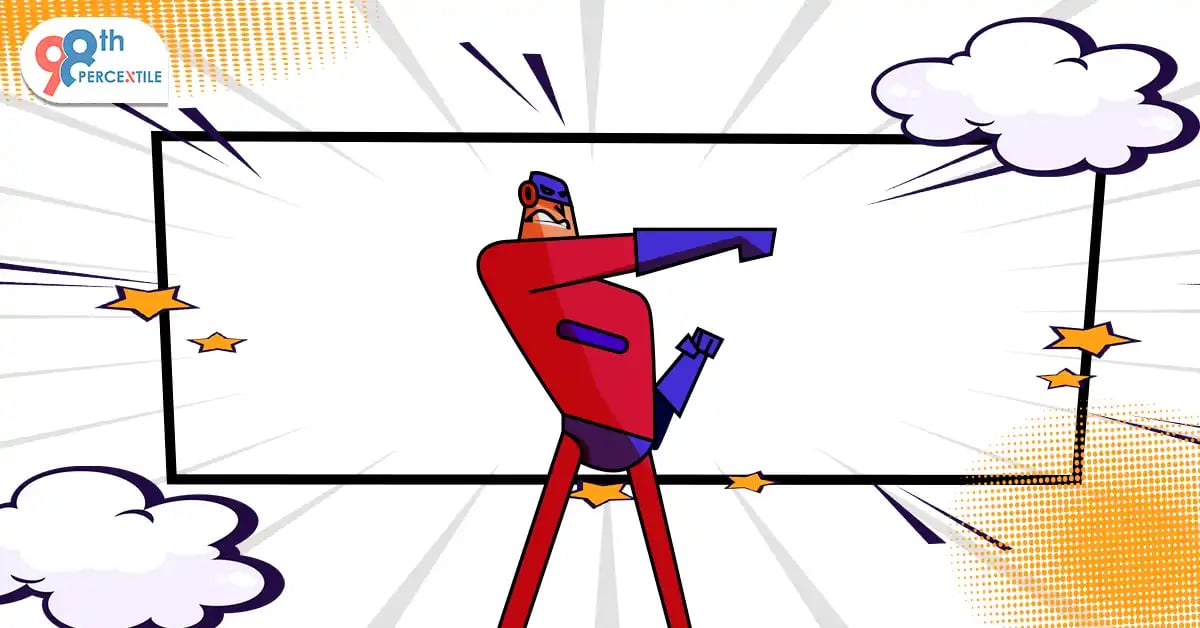Want your child to get into the habit of reading?
Comic strips have been a popular form of entertainment for more than a century, enthralling readers with their distinct combination of comedy, narrative, and artwork.
Comic strips evolved with greater technical and cultural shifts in the twentieth and twenty-first centuries, transitioning from black-and-white newspaper comics to dynamic, interactive digital experiences. This voyage demonstrates the medium's durability and adaptability, assuring its continuous relevance in a constantly changing world.
98thPercentile’s Comix Summer Camp honors this transition and teaches kids to form and design their own comic strips digitally. Students of ages 6-12 across the US can participate in this online competition and stand a chance to win rewards and scholarships worth $1500.
Changing Times for Comic Strips- Panels to Pixels
Let us go through the various eras of comic strip evolution.
The Early Years:
Comic strips originated in the late nineteenth century, with pioneers such as Richard Outcault's "The Yellow Kid" (1895) and Winsor McCay's "Little Nemo in Slumberland" (1905). These early comics were mostly comical, with basic, static graphics presented in a sequential order. They gained popularity in newspapers, offering readers a momentary respite in a fast-industrializing environment.
The Golden Era of Comics:
The 1930s were the Golden Age of Comics, with the introduction of renowned characters like Superman, Batman, and Wonder Woman. Simultaneously, comic strips flourished, with masterpieces such as "Peanuts" by Charles Schulz and "Dick Tracy" by Chester Gould appearing. The art form became an important aspect of American society, reflecting cultural changes and providing social criticism.
Enhance Your Child's Verbal Abilities: Start Trial Now!
Technicolor Age:
As the mid-twentieth century approached, color printing technology made comic strips come to life. Sunday comic strips, in particular, embraced this innovation, enthralling readers with visually appealing and dramatic narratives. Characters like "Garfield" and "Calvin and Hobbes" become household names, demonstrating the medium's continuing appeal.
The age of digital technology
The late twentieth century and the rise of the internet ushered in a seismic upheaval in the world of comic strips. Digital platforms enabled producers to instantaneously access a worldwide audience, overcoming the restrictions of conventional print media. Webcomics arose as a new frontier, allowing independent artists to publish their work while experimenting with various styles and themes.
Interaction and Animation:
With the proliferation of smartphones and tablets, comic strips embraced interactivity and animation. Creators started experimenting with scrollable, interactive forms, which engaged readers in new and fascinating ways. This method was popularized by platforms such as Webtoon and Tapas, which combine narrative and user participation seamlessly.
Social media and Memes:
The incorporation of comic strips onto social media platforms broadened their appeal. Short, amusing cartoons evolved into shareable material, resulting in internet memes that spread quickly throughout the digital environment. Creators discovered new methods to engage with their audiences, leveraging the power of social media to build communities around their work.
Augmented and Virtual Reality:
As technology advances, the possibilities for comic strips increase even further. Augmented reality (AR) and virtual reality (VR) are being investigated as platforms for immersing readers in a more interactive and three-dimensional comic experience. This progression promises to push the boundaries of narrative, giving readers an unparalleled degree of participation.
The history of comic strips from their humble beginnings to the digital era demonstrates their timeless appeal and versatility. Comic strips have developed throughout time, from black-and-white newspaper comics to dynamic, interactive experiences that engage audiences in novel ways. As we look ahead, the path of comic strips continues, providing new opportunities and progress in the ever-changing world of narrative.
Make sure to check out Comix Summer Camp 2024 by 98thPercentile if you want your child to get interested in comic strip creation. It can enhance their verbal and reasoning skills while teaching them the art of storytelling and designing in a fun way.
FAQs (Frequently Asked Questions)
What is Comix summer camp?
Ans- Comix summer camp is an online masterclass cum competition where children of ages 6-12 in the US will learn the art of storytelling and designing a comic strip. After submission the winner will be announced in terms of number of votes or likes on social media. Winners can win up to $1500 worth of rewards and scholarships.
How do trainers teach to create comic strips in Comix Summer Camp?
Ans- Comic experts explain in detail the way to create a comic strip both with pen and paper and digitally. They focus on the digital procedure since that is the way to go nowadays. Step-by-step instructions are given.
What is 98thPercentile?
Ans- 98thPercentile is a major online learning platform having grade accelerated after-school enrichment programs in Math, ELA, Coding and Public speaking.
How has the evolution of comics affected the readership?
Ans- The popularity of comic books and strips on newspapers have gone down considerably and digitally created comics have replaced them. Now it is more easily accessible to kids and teens who have a knack for reading comics. Yet, people who are comic enthusiasts still have an emotional connect with the traditional comic books and don’t miss a chance to buy them.
How has digital era helped comic creators?
Ans- Digital era has made comics more accessible to children and the youth. But a lot of inappropriate comics are also created so parents must monitor as to what their children are reading online.

 Students/Staff
Students/Staff Parents
Parents ElevatEd
ElevatEd




-Nov-18-2025-03-57-47-3267-AM.png?width=360&length=360&name=401x226%20(6)-Nov-18-2025-03-57-47-3267-AM.png)



-Jul-22-2025-03-16-52-8797-AM.png?width=360&length=360&name=401x226%20(6)-Jul-22-2025-03-16-52-8797-AM.png)






